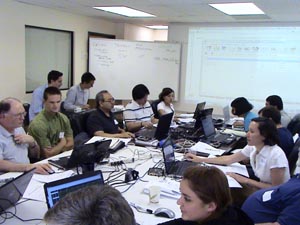
A Center in UNM's School of Engineering is taking the most difficult and sophisticated computer chip technology and teaching the teachers- who will teach the students- who will be on the forefront of building an economy based on imagination and technical skills.
The Configurable Space Microsystems Innovations & Applications Center (COSMIAC) is instructing faculty members from community colleges all over the South and Southwest how to teach courses with Hardware Description Languages (HDL) so their students can design with Field Programmable Gate Array (FPGA) computer chips. It's not easy.
FPGA computer chips are called chameleon chips because they can be reprogrammed after they have been manufactured. For example, a chip that is placed in a satellite and shot into space to enable a camera to photograph water evaporation in California forests could be remotely reprogrammed to enable a camera to monitor traffic jams in California cities. But it takes a very special set of skills to reprogram the chip. The goal of COSMIAC and their team of community college partners is to teach faculty members in community colleges to teach the needed skills to their students.
Last week, faculty members from Luna Community College attended class at COSMIAC. They intend to offer a class on programming FPGA chips next academic year, even though there are no companies in Las Vegas, New Mexico that use these kind of chips. The faculty members hope the ten or so students expected in class will get an Associate Degree and come to UNM or some larger college where they can get a full range of classes and have job opportunities. According to Craig Kief, deputy director of COSMIAC, this type of new technology is critical for community college instructors to be able to provide their students with the skills current industry demands.
FPGA chip programming is much more than learning the computer language to change the job of the computer chip. It's also re-thinking the way changes can be made so the chip can work most efficiently with the hardware at hand in a remote and hostile environment such as space. So the art in the teaching job is finding a way to unleash the technological imagination of students who may come into class just looking for skills to get a job at a decent salary.
This summer faculty members from Arizona State University, Western College, South Mountain Community College, Glendale Community College, Eastern Arizona College, Cochise Community College, Chandler/Gilbert Community College, Glendale Community College, Central Arizona College, Mesa Community College, JF Drake State Technical College, San Juan Community College, Central New Mexico Community College, Luna Community College, Dona Ana Community College, Southwest Indian Polytechnic Institute, Alabama A&M University, Bishop State Community College, Southern Union Community College and Enterprise State Community College were taught by COSMIAC and their team of skilled community college partners to learn the skills they need to teach the courses at their schools. COSMIAC experts use Skype extensively, so when a faculty member is facing a difficult part of the curriculum, they can bring in help via Skype to answer some of the questions.
It is very complex to build a workforce in a field that is completely different from anything that's gone before. Most students and faculty members don't have backgrounds that relate to these skills, but someone has to be on the cutting edge, and after all, someone had to learn to repair the first car.
The project is funded by the National Science Foundation's Advanced Technological Education grant program. COSMIAC has three primary areas of interest. They include Research & Development, Workforce Development and Educational Outreach.
Media contact: Karen Wentworth (505) 277-5627; e-mail: kwent2@unm.edu